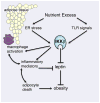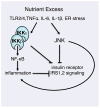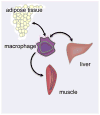NF-κB, inflammation, and metabolic disease
- PMID: 21195345
- PMCID: PMC3040418
- DOI: 10.1016/j.cmet.2010.12.008
NF-κB, inflammation, and metabolic disease
Abstract
Metabolic disorders including obesity, type 2 diabetes, and atherosclerosis have been viewed historically as lipid storage disorders brought about by overnutrition. It is now widely appreciated that chronic low-grade inflammation plays a key role in the initiation, propagation, and development of metabolic diseases. Consistent with its central role in coordinating inflammatory responses, numerous recent studies have implicated the transcription factor NF-κB in the development of such diseases, thereby further establishing inflammation as a critical factor in their etiology and offering hope for the development of new therapeutic approaches for their treatment.
Copyright © 2011 Elsevier Inc. All rights reserved.
Figures





References
-
- Adli M, Baldwin AS. IKK-i/IKKepsilon controls constitutive, cancer cell-associated NF-kappaB activity via regulation of Ser-536 p65/RelA phosphorylation. J Biol Chem. 2006;281:26976–26984. - PubMed
-
- Arkan MC, Hevener AL, Greten FR, Maeda S, Li ZW, Long JM, Wynshaw-Boris A, Poli G, Olefsky J, Karin M. IKK-beta links inflammation to obesity-induced insulin resistance. Nat Med. 2005;11:191–198. - PubMed
-
- Baumgartl J, Baudler S, Scherner M, Babaev V, Makowski L, Suttles J, McDuffie M, Tobe K, Kadowaki T, Fazio S, Kahn CR, Hotamisligil GS, Krone W, Linton M, Bruning JC. Myeloid lineage cell-restricted insulin resistance protects apolipoproteinE-deficient mice against atherosclerosis. Cell Metab. 2006;3:247–256. - PMC - PubMed
-
- Belgardt BF, Husch A, Rother E, Ernst MB, Wunderlich FT, Hampel B, Klockener T, Alessi D, Kloppenburg P, Bruning JC. PDK1 deficiency in POMC-expressing cells reveals FOXO1-dependent and -independent pathways in control of energy homeostasis and stress response. Cell Metab. 2008;7:291–301. - PubMed
Publication types
MeSH terms
Substances
Grants and funding
LinkOut - more resources
Full Text Sources
Other Literature Sources
Medical

